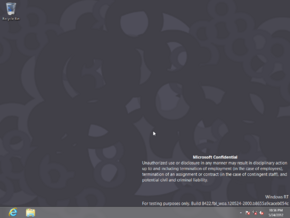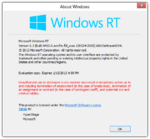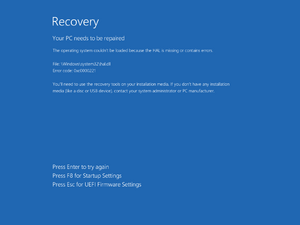Windows 8 build 8422 (fbl_woa)
| Build of Windows 8 | |
 | |
| OS family | Windows NT |
|---|---|
| Version number | 6.2 |
| Build number | 8422 |
| Build revision | 0 |
| Architecture | ARM32 |
| Build lab | fbl_woa |
| Compiled on | 2012-05-24 |
| Expiration date | |
| Timebomb | 2013-01-15 (+236 days) |
| SKUs | |
| RT (CoreARM) | |
| Product key | |
| NFV72-RG2HG-7FTTP-8FJTB-FF848 | |
| About dialog | |
Windows 8 build 8422 (fbl_woa) is a build of Windows 8, which was uploaded to BetaArchive on 19 February 2019 in the ARM32 architecture.
Installation[edit | edit source]
QEMU installation guide:
Prerequisites[edit | edit source]
The following requirements used in order to install this build onto a virtual machine are listed below:
- A copy of QEMU v6.2.0, modified for Windows RT compatibility
- A version of the firmware designed for ARM32 emulation (https://github.com/pivotman319-owo/woahefi-nt6x/releases/tag/r0.01), to be placed in the QEMU installation directory under
fw/QEMU_EFI_woahefi.fd - One virtual hard disk image (for storing the operating system)
Precautions[edit | edit source]
- Certain Windows 8 builds (such as 8330 (fbl_woa) or 8422 (fbl_woa)) may fail to properly load certain binaries on most startup attempts due to an emulation bug that causes the boot environment to read files incorrectly (especially the Hardware Abstraction Layer) causing an invalid checksum error, despite the files themselves being unmodified. This can be worked around by attempting to retry the startup attempt multiple times.
- USB emulation is largely unstable and may result in all input devices failing to register any user inputs. To restore input, switch to the QEMU compatibility monitor (Ctrl+Alt+2) and run the following commands:
device_del kbd device_add usb-kbd,id=kbd device_del mice device_add usb-tablet,id=mice
- Multiple BSODs might cause "Preparing Automatic Repair" messages, an early boot error will appear afterwards.
- As of 2024, builds within the 85xx-9200 range cannot be booted on QEMU because the Hardware Abstraction Layer (HAL) implementation in these builds is not compatible with the current state of emulated ARM system. This can be resolved by replacing
hal.dllwith the one in 8439 and disabling Driver Signing Enforcement (DSE).
Instructions[edit | edit source]
Create the needed virtual disk image through the diskpart utility by running the below script; they will be created under a directory in the C: drive named ARM8. The partitions it will contain will be respectively mounted under drive letters F and P.
create vdisk file="C:\ARM8\HDD.vhd" maximum=65536 type=expandable select vdisk file="C:\ARM8\HDD.vhd" attach vdisk convert gpt create partition efi size=100 format quick fs=fat32 assign letter=F create partition primary format quick fs=ntfs assign letter=P exit
Deploy the image and apply the generic product key from the build's installation media by invoking the following DISM commands, then add the boot files to the EFI partition:
DISM /Apply-Image /ImageFile:"X:\path\to\install.wim" /ApplyDir:P:\ /Index:1 DISM /Image:P:\ /Set-ProductKey:NFV72-RG2HG-7FTTP-8FJTB-FF848 /AcceptEula bcdboot "P:\Windows" /s F: /f UEFI
Eject the currently attached virtual disk from the machine, then paste and run the contents of the below script onto a batch file within the QEMU installation directory, replacing YYYY-MM-DD with the build's compile date:
set MAIN="C:\ARM8\HDD.vhd"
qemu-system-arm ^
-M virt,force_el3=true,force_psci=true,pci=false,highmem=false ^
-cpu cortex-a15 -smp cores=4,threads=2 -m 2048 ^
-device usb-kbd,id=kbd -device usb-tablet,id=mice ^
-drive id=SD,if=none,file=%MAIN% -device sd-card,drive=SD ^
-bios fw\QEMU_EFI_1512_driver1998.fd -device VGA ^
-rtc base=YYYY-MM-DD,clock=vm ^
--accel tcg,thread=multi
Continue installing the operating system through normal means.
Changes[edit | edit source]
Windows Setup[edit | edit source]
The respective boot string used to display registry changes performed by SetupCl prior to the second phase of setup has been nullified.
Out-of-box experience[edit | edit source]
A new first logon animation that instructs the user on how to use the charms bar, demonstrated with both desktop and touch modes.
Interface[edit | edit source]
Logon UI[edit | edit source]
Power options are now accessible when the device is locked.
Internet Explorer[edit | edit source]
The pin tile button in the immersive Internet Explorer 10 user interface has been changed to display a drop-down menu that lets the user either add a site to their favorites list or pin it directly to the start screen. The default set of favorited items from the desktop counterpart are now also present in the immersive version.
Miscellaneous[edit | edit source]
The default wallpaper set has been reverted to the variant observed in earlier 83xx-series development builds, and the provided set of Start screen patterns have also been changed back to those observed in the Windows 8 Consumer Preview. The File Explorer's present name has been introduced, in light of the changes introduced as part of the new Windows 8 user interface.
Bugs[edit | edit source]
Setup[edit | edit source]
Setup may appear to freeze at the end. Hard resetting the device will allow the user to complete setup.
User profiles[edit | edit source]
Start screen tile scaling does not work correctly for the default user profile's Desktop tile. It must be manually resized to its original scale after creating a user account and logging into it for the first time.
Gallery[edit | edit source]
Setup[edit | edit source]
Interface[edit | edit source]
Metro UI[edit | edit source]
About Internet Explorer
About Windows Store
Desktop UI[edit | edit source]
Windows Basic theme






















